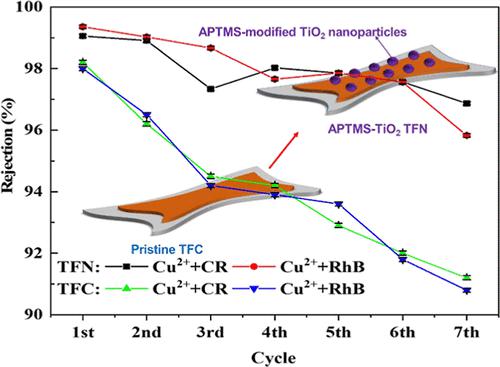当前位置:
X-MOL 学术
›
ACS Appl. Polym. Mater.
›
论文详情
Our official English website, www.x-mol.net, welcomes your
feedback! (Note: you will need to create a separate account there.)
(3-Aminopropyl)trimethoxysilane-Functionalized Titanium Dioxide Thin-Film Nanocomposite Membrane: Enhanced Rejection Performance for Unary and Binary High-Salt Wastewater
ACS Applied Polymer Materials ( IF 4.4 ) Pub Date : 2023-11-22 , DOI: 10.1021/acsapm.3c01932
Yingying Zhu 1 , Yang Xu 1, 2 , Siqi Chen 1 , Yifan Zhou 1 , Jinyuan Zhu 1 , Geng Chen 1
ACS Applied Polymer Materials ( IF 4.4 ) Pub Date : 2023-11-22 , DOI: 10.1021/acsapm.3c01932
Yingying Zhu 1 , Yang Xu 1, 2 , Siqi Chen 1 , Yifan Zhou 1 , Jinyuan Zhu 1 , Geng Chen 1
Affiliation

|
Titanium dioxide (TiO2) nanoparticles act as very good nanofillers to prepare the polymeric nanocomposite membranes to tackle the problem of heavy metal pollution in the water body. A key challenge to be solved is to improve their compatibility with organic matrices and dispersion in the material. Herein, (3-aminopropyl)trimethoxysilane-modified TiO2 (APTMS-TiO2) was prepared using coupling agent modification, and APTMS-TiO2 thin-film nanocomposite (TFN) membrane was successfully applied in the forward osmosis (FO) process. Moreover, the effects of different pretreated TiO2, TiO2 dosages, draw solution types, and concentrations on FO membranes were systematically studied. Results showed that APTMS-TiO2 TFN with a TiO2 dosage of 0.05 wt % has the maximal water permeate flux (Jw) (18.14 LMH, 225.09% higher than the control TFC of 5.58 LMH) and the minimum specific reverse solute flux of 0.40 g/L with 1 M NaCl as the draw. Unary (Cu2+ and Ni2+) and binary (Cu2+ + CR and Cu2+ + RhB) high-salt wastewater were applied as the feed to investigate the reusability and dye rejection of the APTMS-TiO2 TFN. The rejection rate of Cu2+ and Ni2+ by APTMS-TiO2 TFN was above 98.00 and 97.00%, respectively, while the rejection rate of Cu2+ + CR and Cu2+ + RhB was 96.87 and 95.83%, respectively, indicating excellent reusability and rejection. The present research finding concludes that the incorporation of APTMS-TiO2 nanosheets in the TFN layer enhances the flux and rejection of targeted mineral salts. Additionally, the APTMS-TiO2 TFN revealed outstanding rejection performance of unary and binary wastewaters, signifying that contact with heavy metals and colored solutes will not affect the performance.
中文翻译:

(3-氨基丙基)三甲氧基硅烷-功能化二氧化钛薄膜纳米复合膜:增强一元和二元高盐废水的截留性能
二氧化钛(TiO 2)纳米粒子作为非常好的纳米填料来制备聚合物纳米复合膜,以解决水体中的重金属污染问题。需要解决的一个关键挑战是提高它们与有机基体的相容性以及在材料中的分散性。本文通过偶联剂改性制备了(3-氨基丙基)三甲氧基硅烷改性TiO 2 (APTMS-TiO 2 ),并将APTMS-TiO 2薄膜纳米复合(TFN)膜成功应用于正向渗透(FO)过程。此外,系统研究了不同预处理的TiO 2、TiO 2用量、驱动液类型和浓度对FO膜的影响。结果表明,TiO 2 用量为0.05 wt %的APTMS-TiO 2 TFN具有最大水渗透通量(J w)(18.14 LMH,比对照TFC 5.58 LMH高225.09%),最小比反溶质通量为0.40 g/L,用 1 M NaCl 作为提取物。以一元(Cu 2+和 Ni 2+)和二元(Cu 2+ + CR 和 Cu 2+ + RhB)高盐废水为进料,研究 APTMS-TiO 2 TFN 的可重复使用性和染料截留率。APTMS-TiO 2 TFN对Cu 2+和Ni 2+的截留率分别达到98.00和97.00%以上,而Cu 2 ++ CR和Cu 2 ++ RhB的截留率分别为96.87和95.83%。表明具有良好的可重用性和排斥性。目前的研究结果得出结论,在 TFN 层中加入 APTMS-TiO 2纳米片可增强目标矿物盐的通量和截留率。此外,APTMS-TiO 2 TFN 对一元和二元废水表现出出色的截留性能,这意味着与重金属和有色溶质的接触不会影响其性能。
更新日期:2023-11-22
中文翻译:

(3-氨基丙基)三甲氧基硅烷-功能化二氧化钛薄膜纳米复合膜:增强一元和二元高盐废水的截留性能
二氧化钛(TiO 2)纳米粒子作为非常好的纳米填料来制备聚合物纳米复合膜,以解决水体中的重金属污染问题。需要解决的一个关键挑战是提高它们与有机基体的相容性以及在材料中的分散性。本文通过偶联剂改性制备了(3-氨基丙基)三甲氧基硅烷改性TiO 2 (APTMS-TiO 2 ),并将APTMS-TiO 2薄膜纳米复合(TFN)膜成功应用于正向渗透(FO)过程。此外,系统研究了不同预处理的TiO 2、TiO 2用量、驱动液类型和浓度对FO膜的影响。结果表明,TiO 2 用量为0.05 wt %的APTMS-TiO 2 TFN具有最大水渗透通量(J w)(18.14 LMH,比对照TFC 5.58 LMH高225.09%),最小比反溶质通量为0.40 g/L,用 1 M NaCl 作为提取物。以一元(Cu 2+和 Ni 2+)和二元(Cu 2+ + CR 和 Cu 2+ + RhB)高盐废水为进料,研究 APTMS-TiO 2 TFN 的可重复使用性和染料截留率。APTMS-TiO 2 TFN对Cu 2+和Ni 2+的截留率分别达到98.00和97.00%以上,而Cu 2 ++ CR和Cu 2 ++ RhB的截留率分别为96.87和95.83%。表明具有良好的可重用性和排斥性。目前的研究结果得出结论,在 TFN 层中加入 APTMS-TiO 2纳米片可增强目标矿物盐的通量和截留率。此外,APTMS-TiO 2 TFN 对一元和二元废水表现出出色的截留性能,这意味着与重金属和有色溶质的接触不会影响其性能。

































 京公网安备 11010802027423号
京公网安备 11010802027423号